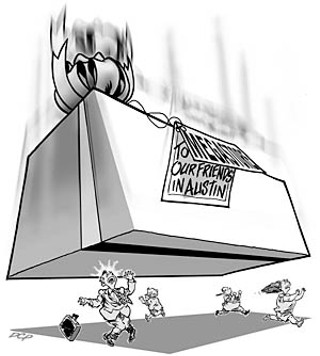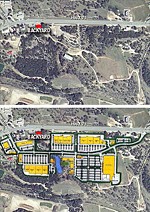Austin @ Large: The Big-Box Big Deal
Little things mean a lot, but design standards aren't simply superficial
By Mike Clark-Madison, Fri., April 2, 2004

While you were drinking, listening to the hot Aussie bands, and/or watching basketball, hardier souls than you have spent Mad March cogitating over big-box retail and its discontents. City staffers, consultants, boards and commissions, stakeholder groups, and the other Oompa Loompas appear to be heading for the homestretch, and City Hall should be able to articulate a strategy for combating commercial sprawl and its resulting environmental, economic, and architectural damage soon, before its attentions get fully consumed (again) by the city's fiscal and budgetary problems.
The most direct City Hall response – banning big boxes over the Edwards Aquifer – happened some time ago, at least to the degree that Austin can do much about it on its own. It's apparently up to activists like the Save Our Springs Alliance to slap some sense on the courthouse steps into surrounding communities like Bee Cave, where yet another Lowe's now lingers in legal limbo. (Regional planning, anyone?) As for the question of economic impact – currently being studied by consultants Jon Hockenyos and Scott Polikov – community and small-business leaders are quietly grumbling about the city's plodding pace and looking to the City Council to concede what they think is obvious: that enabling and subsidizing big-box sprawl by behemoth global chains is bad for small and unique local businesses in the urban core, QED.
But the city seems to be burning rubber on the third big-box front – imposing design standards on large-scale commercial development, an effort championed by Council Member Brewster McCracken that would bring Austin in line with Bee Cave and its other tiny (and tony) neighbors. (You can contribute to the cause by taking the city's visual-preference survey online at www.cityofaustin.org. If you have even a small bit of taste and sense, the choices presented to you should be easy and clear.)
While design standards would seem to be the least significant element of an Austin anti-sprawl strategy, any progress on this front is to be cheered; citizens should be unwilling to accept that any part of town – no matter how suburban, new, or low- to middle-income – will look ugly and cheap. But big-box design standards will only be valuable, and perhaps even enforceable, as part of the larger framework of land-use planning (preferably on a regional scale) and economic strategy the city needs to embrace if it has any hope of making meaningful its commitment to Keeping Austin Weird and not becoming just another frontier outpost of Generica.
EZ Now, Hard Later
The design-standards effort has gained traction because – to the evident surprise of many – real estate types (well, some of them) have embraced it with enthusiasm. Cynics assume this is a diversionary tactic – make the Wal-Marts pretty, and people will forget they're Wal-Marts – but industry support is also pragmatic. There's a reason design standards exist in places like Bee Cave and West Lake Hills and Rollingwood that are devoid of poor people – ugly and dysfunctional retail sprawl along highway strips depresses property values. Sometimes, developers like that, or at least don't worry about it when paving over raw acreage in hitherto lower-income ZIP codes. But inevitably, as those areas get built up and accumulate some middle-class homeownership, the real estate community – which for decades has pursued the above-market-rate suburban housing buyer to the exclusion of most other customers – starts to see EZ-Build tilt-wall super-low-rise sprawl as problematic.
They're right, and the city should take heed. The biggest problem Austin faces with big boxes is the enormous opportunity cost of allowing developers to pursue the easiest money down the path of least resistance. Land, especially in large and raw chunks, is not really in ample supply in Central Texas, even in the Desired Development Zones. When you factor in the needs for new road and water infrastructure – which have already left this region heavily in debt – it becomes even more imperative that the city makes every parcel count to meet community needs and bring in net revenue for years to come.
Turning huge tracts of land into big-box power centers that provide neither housing nor high-value employment, that only remain viable for 20 years, whose contribution to the local tax base remains static at best, that place huge demands on infrastructure, and that are almost impossible to redevelop, is not what you call Smart Growth, in any sense; at least residential sprawl can promise the benefit of increasing home ownership, which is to the public's good. In the long run, Wal-Martization is really only good for Wal-Mart. To allow a few unplanned big-box hot corners to define, and depress, entire commercial corridors takes what limited leverage Austin has over its long-term future as an urban economic center and throws it into the ditch.
High Stakes
The city seems, ever so slowly, to be realizing that it has the power to address these problems by regulating land use. (Who'da thunk?) Design standards are, or should be, not simply icing on that cake but an integral ingredient of the land-use recipe. After all, whether it's a big-box monstrosity like the twin centers at Tech Ridge (I-35 at Parmer Lane), or the Smart-Grown mixed-use transit-friendly local-and-national retail center of the community's dreams, it's still zoned GR (general retail). Design standards can lock into place the differences Austinites want to see.
Those are all more questions of "design" than they are of "land use." But even the aesthetic rules generally understood as "design standards" have a role to play in the big picture. Simply put, by regulating the appearance of big boxes – the choice of materials, the location of windows and entrances, the style of signage, the orientation to the street – you can make centers places where people want to be, instead of the hell holes they too often are. This increases their value as property, as tax generators, as assets to surrounding neighborhoods. That opens up the potential for redevelopment of the adjacent corridors along similar lines.
And that brings Austin closer to the goals of sustainability and economic vitality its leaders love to talk about. Hopefully, those leaders will realize, as their attentions return to the big-box battle, how much is at stake, and how much can be achieved if they do this right. ![]()
Got something to say on the subject? Send a letter to the editor.










